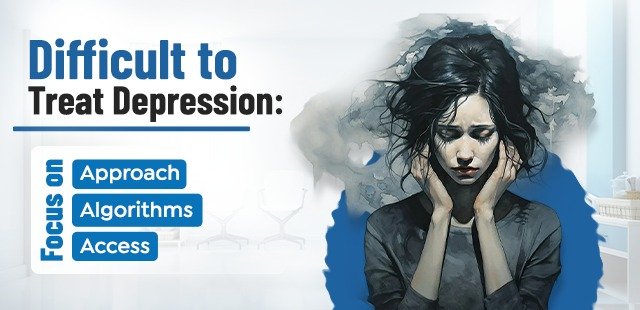Difficult to Treat Depression: Focus on Approach, Algorithms, and Access
Difficult to Treat Depression: Focus on Approach, Algorithms, and Access

The most common mental problem of this era – Depression. It’s difficult to treat depression from the root but not impossible! There are several ways you would listen to treat depression from friends, therapists, relatives, and well-wishers, but this blog is different in its own way to treat it.
Understanding and addressing DTD(Difficult to Treat Depression) requires a comprehensive focus on innovative approaches, personalized treatment algorithms, and improving access to care. This blog explores these three critical aspects of tackling DTD effectively. However, the challenges of treating depression to remission in adult patients who do not respond to first, second, or third levels of oral pharmacotherapy remain constant.
Understanding Difficult-to-Treat Depression
DTD- This refers to a type of depression that continues to cause significant burden despite standard treatment efforts, meaning the patient doesn’t experience adequate symptom relief even with multiple treatment options like therapy or medication.
We often force ourselves to be happy in our surroundings but deep inside we only know what we suffer from, and to tackle it we need to treat it wisely. And treatment is necessary to tackle all this depression.
Innovative Approaches to Treatment
Therapies in the current era works like a boom for DTD patients, it just not works as a medication but also as a healing element. Here are few medications and therapies through which depression can be reduced
- Personalized Medicine: Using appropriate medicines and personal psychiatry is required for the easy treatment of DTD. Applying clinical treatments and medications can reduce the effect of it. This approach reduces trial-and-error in prescribing medications and optimizes therapeutic outcomes.
- Neuromodulation Therapies:Techniques like Transcranial Magnetic Stimulation (TMS) and Electroconvulsive Therapy (ECT) offer non-invasive or minimally invasive alternatives for patients who do not respond to conventional treatments. If in case any medications fail to work on the brain regions then these treatments can help to calm it.
- Lifestyle Interventions:Incorporating exercises, yoga, mindfulness, stretching activities, and even meditations can help to calm down the stress incurred in your brain. Physical activities can boost your lifestyle and decrease Depression because you are involved and focused. Effective treatments reduce symptoms, healthcare utilization, and associated costs, but approximately 50%.
Improving Access to Care
Accessibility is a significant barrier for many individuals with DTD, particularly in underserved populations. Addressing this challenge requires systemic changes in healthcare delivery:
- Expanding Telehealth Services: Remotely the digital health services are adding value to care of depression patients, from updating reports, online medical tips etc.
- Telepsychiatry: This bridges the gap between patients and mental health professionals, especially in rural or remote areas. Virtual platforms enable timely consultations and continuity of care.
- Reducing Financial Barriers: By not focusing more on medicals and treatments one can go for therapies and most importantly sharing what they feel, this helps to tackle the problem of depression. This can reduce the burden of consultations, medical bills and many more
- Insurance coverage for advanced treatments like TMS and ketamine therapy must be expanded to ensure affordability. Additionally, public health programs should subsidize care for low-income individuals.
Conclusion
Difficult-to-treat depression is a complex condition that challenges both patients and clinicians. By adopting innovative approaches, leveraging personalized treatment algorithms, and addressing barriers to care, the mental health community can enhance outcomes for individuals struggling with DTD. Collaboration among researchers, healthcare providers, policymakers, and patients is crucial in ensuring that everyone has access to effective, evidence-based care.
While DTD may present formidable challenges, a commitment to advancing understanding, embracing innovation, and fostering inclusivity offers hope for a brighter future in mental health care.